Memory Stick Pro on:
[Wikipedia]
[Google]
[Amazon]
The Memory Stick is a removable
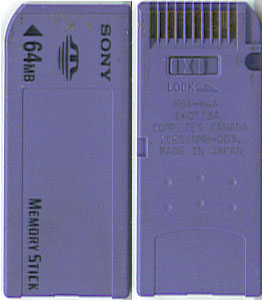
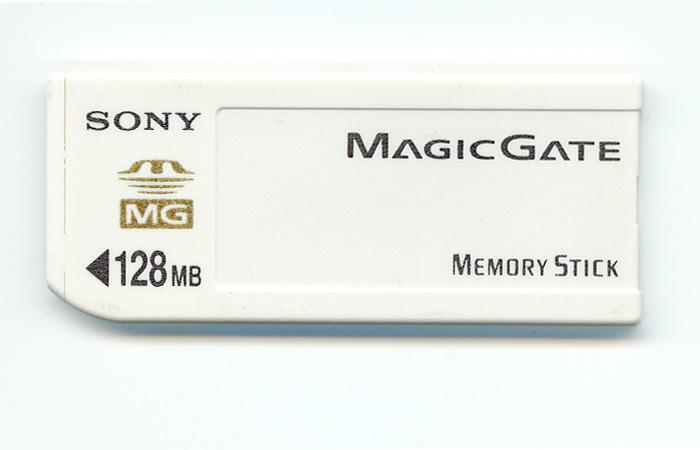 The original Memory Stick is approximately the size and thickness of a stick of chewing gum. It was available in capacities from 4 MB to 128 MB (1 MB = one million bytes). It was available both with and without
The original Memory Stick is approximately the size and thickness of a stick of chewing gum. It was available in capacities from 4 MB to 128 MB (1 MB = one million bytes). It was available both with and without
 In response to the storage limitations of the original Memory Stick, Sony introduced the Memory Stick Select at CES 2003 on January 9. The Memory Stick Select contained two separate 128 MB partitions which the user could switch between using a physical switch on the card. This solution was fairly unpopular, but it did give users of older Memory Stick devices more capacity. Its physical size remained the same as the original Memory Stick.
In response to the storage limitations of the original Memory Stick, Sony introduced the Memory Stick Select at CES 2003 on January 9. The Memory Stick Select contained two separate 128 MB partitions which the user could switch between using a physical switch on the card. This solution was fairly unpopular, but it did give users of older Memory Stick devices more capacity. Its physical size remained the same as the original Memory Stick.
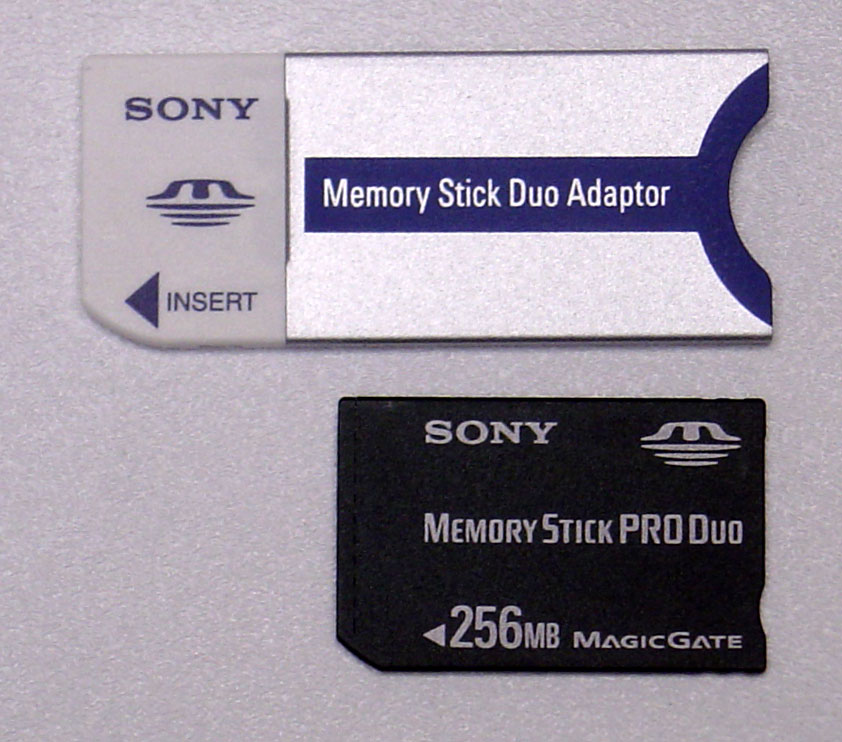 A simple adapter allows Memory Stick Duo to be used in devices designed to accept the original Memory Stick form factor.
A simple adapter allows Memory Stick Duo to be used in devices designed to accept the original Memory Stick form factor.
 The Memory Stick PRO Duo (MSPD) quickly replaced the Memory Stick Duo due to the Duo's size limitation of 128 MB and slow transfer speed. Memory Stick PRO Duos are available in all the same variants as the larger Memory Stick PRO, with and without High Speed mode, and with and without MagicGate support.
Sony has released different versions of Memory Stick PRO Duo. A Memory Stick PRO Duo with MagicGate was released as a 512 MB stick. Additionally, a 16 GB version in March 2008 and another a 32 GB version on August 21, 2009. In 2009, Sony and SanDisk also announced the joint development of an expanded Memory Stick PRO format tentatively named "Memory Stick PRO Format for Extended High Capacity". Sony has since finalized the format and released its specification under the new name, ''Memory Stick XC'' (see below).
The Memory Stick PRO Duo (MSPD) quickly replaced the Memory Stick Duo due to the Duo's size limitation of 128 MB and slow transfer speed. Memory Stick PRO Duos are available in all the same variants as the larger Memory Stick PRO, with and without High Speed mode, and with and without MagicGate support.
Sony has released different versions of Memory Stick PRO Duo. A Memory Stick PRO Duo with MagicGate was released as a 512 MB stick. Additionally, a 16 GB version in March 2008 and another a 32 GB version on August 21, 2009. In 2009, Sony and SanDisk also announced the joint development of an expanded Memory Stick PRO format tentatively named "Memory Stick PRO Format for Extended High Capacity". Sony has since finalized the format and released its specification under the new name, ''Memory Stick XC'' (see below).
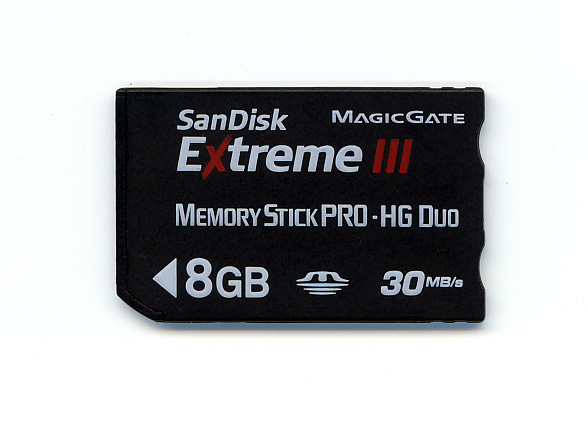 On December 11, 2006, Sony, together with
On December 11, 2006, Sony, together with
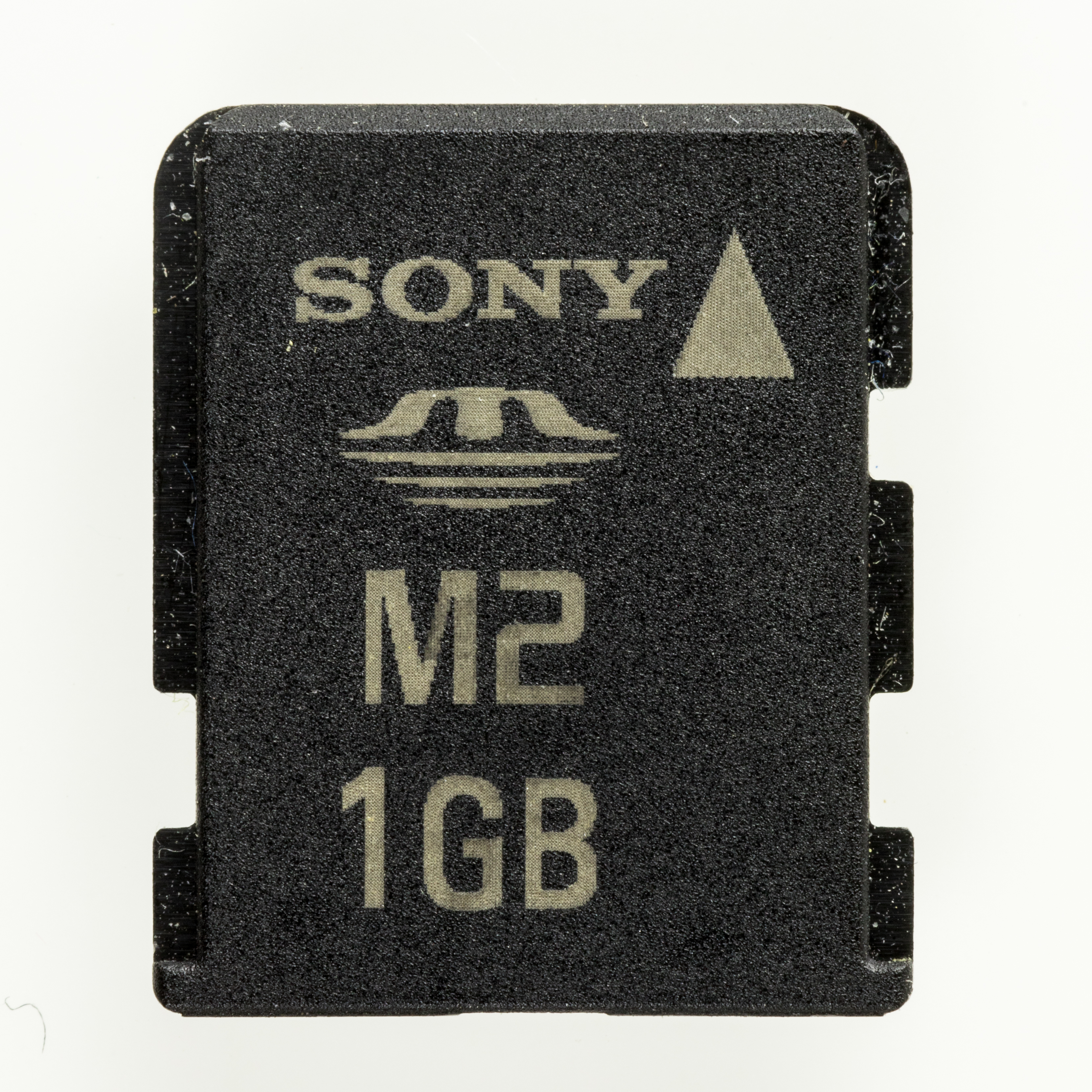 In a joint venture with
In a joint venture with
Sony's official One Stop Site for Formats
with some specifications of the electrical interface.
Memory Stick products at Sony Singapore
SanDisk and Sony develop “Memory Stick Micro” (M2) format
– SanDisk/Sony press release, September 30, 2005. *SanDis
– December 1, 2006.
Complete Memory Stick® Media Compatibility Information for Sony® Digital Cameras
Sony eSupport July 2011. {{Sony Corp Brands that became generic Computer-related introductions in 1998 Solid-state computer storage media Sony products
flash
Flash, flashes, or FLASH may refer to:
Arts, entertainment, and media
Fictional aliases
* Flash (DC Comics character), several DC Comics superheroes with super speed:
** Flash (Barry Allen)
** Flash (Jay Garrick)
** Wally West, the first Kid F ...
memory card
A memory card is an electronic data storage device used for storing digital information, typically using flash memory. These are commonly used in digital portable electronic devices. They allow adding memory to such devices using a card in a soc ...
format, originally launched by Sony
, commonly stylized as SONY, is a Japanese multinational conglomerate corporation headquartered in Minato, Tokyo, Japan. As a major technology company, it operates as one of the world's largest manufacturers of consumer and professional ...
in late 1998. In addition to the original Memory Stick, this family includes the Memory Stick PRO, a revision that allows greater maximum storage capacity and faster file transfer speeds; Memory Stick Duo, a small-form-factor version of the Memory Stick (including the PRO Duo); the even smaller Memory Stick Micro (M2), and the Memory Stick PRO-HG, a high speed variant of the PRO to be used in high-definition video
High-definition video (HD video) is video of higher resolution and quality than standard-definition. While there is no standardized meaning for ''high-definition'', generally any video image with considerably more than 480 vertical scan lines ( ...
and still cameras.
As a proprietary format, Sony exclusively used Memory Stick on its products in the 2000s such as Cyber-shot
Cyber-shot is Sony's line of point-and-shoot digital cameras introduced in 1996. Cyber-shot model names use a DSC prefix, which is an initialism for "Digital Still Camera". Many Cyber-shot models feature Carl Zeiss trademarked lenses, while oth ...
digital cameras, Handycam
Handycam is a Sony brand used to market its camcorder range. It was launched in 1985 as the name of the first Video8 camcorder, replacing Sony's previous line of Betamax-based models, and the name was intended to emphasize the "handy" palm size ...
digital camcorders, WEGA and Bravia
Bravia (stylized as BRAVIA) is a brand of Sony Visual Products Inc., a wholly owned subsidiary of Sony Corporation, and used for its television products. Its backronym is "Best Resolution Audio Visual Integrated Architecture". All Sony high-defi ...
TV sets, VAIO PCs, digital audio players, and the PlayStation Portable
The PlayStation Portable (PSP) is a handheld game console developed and marketed by Sony Computer Entertainment. It was first released in Japan on December 12, 2004, in North America on March 24, 2005, and in PAL regions on September 1, 200 ...
game console, with the format being licensed to a few other companies early in its lifetime. With the increasing popularity of Secure Digital
Secure Digital, officially abbreviated as SD, is a proprietary non-volatile flash memory card format developed by the SD Association (SDA) for use in portable devices.
The standard was introduced in August 1999 by joint efforts between Sa ...
around 2010, Sony started to include SD in their devices which was seen as a Sony loss in the memory-card business. Despite this, Sony continues to support Memory Stick on certain devices.
History
The original Memory Stick, which was launched in October 1998, was available in capacities up to 128 MB. In October 1999, Sony licensed the technology toFujitsu
is a Japanese multinational information and communications technology equipment and services corporation, established in 1935 and headquartered in Tokyo. Fujitsu is the world's sixth-largest IT services provider by annual revenue, and the la ...
, Aiwa
is a consumer electronics brand owned and used by various companies in different regions of the world. American and other regions are owned by Chicago-based Aiwa Corporation. Towada Audio based in Tokyo owns the rights to the brand in Jap ...
, Sanyo
, stylized as SANYO, is a Japanese electronics company and formerly a member of the ''Fortune'' Global 500 whose headquarters was located in Moriguchi, Osaka prefecture, Japan. Sanyo had over 230 subsidiaries and affiliates, and was founded b ...
, Sharp, Pioneer and Kenwood, in a bid to avoid a repetition of the Betamax
Betamax (also known as Beta, as in its logo) is a consumer-level analog recording and cassette format of magnetic tape for video, commonly known as a video cassette recorder. It was developed by Sony and was released in Japan on May 10, 197 ...
failure. Other companies were also licensees to the format. Some early examples of Memory Stick usage by third-party companies include Sharp's MP3 players, Alpine's in-dash players, and Epson
Seiko Epson Corporation, or simply known as Epson, is a Japanese multinational electronics company and one of the world's largest manufacturers of computer printers and information- and imaging-related equipment. Headquartered in Suwa, Nagano ...
's printers.
Initially the format had a lukewarm reception, but it soon increased in popularity, especially after the licensing deal. In spring 2001, Memory Stick attained 25% market share (against CompactFlash
CompactFlash (CF) is a flash memory mass storage device used mainly in portable electronic devices. The format was specified and the devices were first manufactured by SanDisk in 1994.
CompactFlash became one of the most successful of the ...
's 40% and SmartMedia
SmartMedia is an obsolete flash memory card standard owned by Toshiba, with capacities ranging from 2 MB to 128 MB. The format mostly saw application in the early 2000s in digital cameras and audio production. SmartMedia memory cards ar ...
's 32%), up from 7% a year earlier. By May 2001, total shipment of Memory Stick units surpassed 10 million.
However the SD card
Secure Digital, officially abbreviated as SD, is a proprietary non-volatile flash memory card format developed by the SD Association (SDA) for use in portable devices.
The standard was introduced in August 1999 by joint efforts between San ...
, jointly developed by Toshiba
, commonly known as Toshiba and stylized as TOSHIBA, is a Japanese multinational conglomerate corporation headquartered in Minato, Tokyo, Japan. Its diversified products and services include power, industrial and social infrastructure systems ...
, Panasonic
formerly between 1935 and 2008 and the first incarnation of between 2008 and 2022, is a major Japanese multinational conglomerate corporation, headquartered in Kadoma, Osaka. It was founded by Kōnosuke Matsushita in 1918 as a lightbulb ...
and SanDisk
SanDisk is a brand for flash memory products, including memory cards and readers, USB flash drives, solid-state drives, and digital audio players, manufactured and marketed by Western Digital. The original company, SanDisk Corporation was acquire ...
, became widely popular among companies and soon became the most popular flash format by November 2003 it held 42% market share in the United States, ahead of CompactFlash's 26% and Memory Stick with 16%. Eventually Sony itself became the only company to support the format. Sony was often criticized for the Memory Stick, as they were deemed to be expensive compared to other formats.
, it appeared that Sony had begun to combine support for SD/SDHC
Secure Digital, officially abbreviated as SD, is a proprietary non-volatile flash memory card format developed by the SD Association (SDA) for use in portable devices.
The standard was introduced in August 1999 by joint efforts between Sa ...
and Memory Stick formats in their products. All digital cameras and camcorders announced by Sony at the 2010 Consumer Electronics Show could use SD and SDHC
Secure Digital, officially abbreviated as SD, is a proprietary non-volatile flash memory card format developed by the SD Association (SDA) for use in portable devices.
The standard was introduced in August 1999 by joint efforts between Sa ...
cards as well as Memory Sticks. Furthermore, Sony announced the release of its own line of SD cards. Many claimed this development as the end of the format war
A format war is a competition between similar but mutually incompatible technical standards that compete for the same market, such as for data storage devices and recording formats for electronic media. It is often characterized by political a ...
between Memory Stick and SD card. However, Sony did not abandon the format at this time, and indicated that it would continue development of the format for the foreseeable future. A prime example was the development of WiFi transfers through a special Memory Stick PRO-Duo which was still in development .
Sony's first significant migration away from Memory Stick did not come until 2019, when it introduced the α7R IV full-frame mirrorless interchangeable-lens camera without Memory Stick support, opting instead for dual SDXC
Secure Digital, officially abbreviated as SD, is a proprietary non-volatile flash memory card format developed by the SD Association (SDA) for use in portable devices.
The standard was introduced in August 1999 by joint efforts between San ...
slots.
Applications
Typically, Memory Sticks are used as storage media for a portable device, in a form that can easily be removed for access by a personal computer. For example, Sony digital compact cameras use Memory Stick for storing image files. With a Memory Stick-capable memory card reader a user can copy the pictures taken with the Sony digital camera to a computer. Sony typically included Memory Stick reader hardware in its first-party consumer electronics, such as digital cameras, digital music players, PDAs,cellular phones
A mobile phone, cellular phone, cell phone, cellphone, handphone, hand phone or pocket phone, sometimes shortened to simply mobile, cell, or just phone, is a portable telephone that can make and receive calls over a radio frequency link whil ...
, the VAIO line of laptop computers, TV sets under the WEGA and Bravia names, and Sony's handheld gaming device, the PlayStation Portable
The PlayStation Portable (PSP) is a handheld game console developed and marketed by Sony Computer Entertainment. It was first released in Japan on December 12, 2004, in North America on March 24, 2005, and in PAL regions on September 1, 200 ...
.
A special Memory Stick can be inserted in the hindquarters of Sony's AIBO
AIBO (''stylized aibo, Artificial Intelligence Robot'', homonymous with , "pal" or "partner" in Japanese) is a series of robotic dogs designed and manufactured by Sony. Sony announced a prototype Aibo in mid-1998, and the first consumer model w ...
robot pet, to enable the use of Aiboware—software intended for use on AIBOs. The Sticks include a copy protection mechanism used by the robot, allowing users to write programs. These are referred to as ''programmable'' or ''programming''. Only 8 MB and 16 MB versions are available.
An adapter was made for the original Memory Stick that allowed them to be used in a floppy disk drive. This adapter, which took CR2016 cells for power, was meant for those who did not have an existing Memory Stick drive.
Formats and form factors
Memory Sticks include a wide range of actual formats, including three different form factors.Memory Stick

 The original Memory Stick is approximately the size and thickness of a stick of chewing gum. It was available in capacities from 4 MB to 128 MB (1 MB = one million bytes). It was available both with and without
The original Memory Stick is approximately the size and thickness of a stick of chewing gum. It was available in capacities from 4 MB to 128 MB (1 MB = one million bytes). It was available both with and without MagicGate
MagicGate (MG) is a copy-protection technology introduced by Sony in 1999 as part of the Secure Digital Music Initiative (SDMI). It works by encrypting the content on the device and using MagicGate chips in both the storage device and the reade ...
support. The MagicGate-capable memory sticks were white-colored, while the standard version was purple. The original Memory Stick is no longer manufactured.
Memory Stick Select
 In response to the storage limitations of the original Memory Stick, Sony introduced the Memory Stick Select at CES 2003 on January 9. The Memory Stick Select contained two separate 128 MB partitions which the user could switch between using a physical switch on the card. This solution was fairly unpopular, but it did give users of older Memory Stick devices more capacity. Its physical size remained the same as the original Memory Stick.
In response to the storage limitations of the original Memory Stick, Sony introduced the Memory Stick Select at CES 2003 on January 9. The Memory Stick Select contained two separate 128 MB partitions which the user could switch between using a physical switch on the card. This solution was fairly unpopular, but it did give users of older Memory Stick devices more capacity. Its physical size remained the same as the original Memory Stick.
Memory Stick PRO
The Memory Stick PRO, introduced on January 9, 2003, as a joint effort between Sony andSanDisk
SanDisk is a brand for flash memory products, including memory cards and readers, USB flash drives, solid-state drives, and digital audio players, manufactured and marketed by Western Digital. The original company, SanDisk Corporation was acquire ...
, would be the longer-lasting solution to the space problem. Most devices that use the original Memory Sticks support both the original and PRO sticks since both formats have identical form factors. Some readers that were not compatible could be upgraded to Memory Stick PRO support via a firmware
In computing, firmware is a specific class of computer software that provides the low-level control for a device's specific hardware. Firmware, such as the BIOS of a personal computer, may contain basic functions of a device, and may provide ...
update. Memory Stick PROs have a marginally higher transfer speed and a maximum ''theoretical'' capacity of 32 GB, although GB-sized capacities of more than 2GB are only available in the PRO Duo form factor. ''High Speed'' Memory Stick PROs are available, and newer devices support this high-speed mode, allowing for faster file transfers. All Memory Stick PROs larger than 1 GB support this high-speed mode, and High Speed Memory Stick PROs are backwards-compatible with devices that don't support the high-speed mode. High-capacity Memory Sticks such as the 4 GB versions are expensive compared to other types of flash memory such as SD cards and CompactFlash. , 512 MB Memory Stick PRO can be bought.
Memory Stick Duo
The Memory Stick Duo was developed in response to Sony's need for a smaller flash memory card for pocket-sized digital cameras, cell phones and thePlayStation Portable
The PlayStation Portable (PSP) is a handheld game console developed and marketed by Sony Computer Entertainment. It was first released in Japan on December 12, 2004, in North America on March 24, 2005, and in PAL regions on September 1, 200 ...
(the later of which supported the Memory Stick PRO Duo variant). It is slightly smaller than the competing Secure Digital
Secure Digital, officially abbreviated as SD, is a proprietary non-volatile flash memory card format developed by the SD Association (SDA) for use in portable devices.
The standard was introduced in August 1999 by joint efforts between Sa ...
(SD) format and roughly two thirds the length of the standard Memory Stick form factor, but costs more. Memory Stick Duos are available with the same features as the larger standard Memory Stick, available with and without high speed mode, and with and without MagicGate support. The Memory Stick PRO Duo has replaced the Memory Stick Duo due to its 128 MB size limitation, but has kept the same form factor as the Duo.
 A simple adapter allows Memory Stick Duo to be used in devices designed to accept the original Memory Stick form factor.
A simple adapter allows Memory Stick Duo to be used in devices designed to accept the original Memory Stick form factor.
Memory Stick PRO Duo
Memory Stick PRO-HG Duo
 On December 11, 2006, Sony, together with
On December 11, 2006, Sony, together with SanDisk
SanDisk is a brand for flash memory products, including memory cards and readers, USB flash drives, solid-state drives, and digital audio players, manufactured and marketed by Western Digital. The original company, SanDisk Corporation was acquire ...
, announced the Memory Stick PRO-HG Duo. While only serial and 4-bit parallel interfaces are supported in the Memory Stick PRO format, an 8-bit parallel interface was added to the Memory Stick PRO-HG format. Also, the maximum interface clock frequency was increased from 40 MHz to 60 MHz. With these enhancements, a theoretical transfer rate of 480 Mbit/s (60 MB/s) is achieved, which is three times faster than the Memory Stick PRO format.
Memory Stick Micro (M2)
 In a joint venture with
In a joint venture with SanDisk
SanDisk is a brand for flash memory products, including memory cards and readers, USB flash drives, solid-state drives, and digital audio players, manufactured and marketed by Western Digital. The original company, SanDisk Corporation was acquire ...
, Sony released a new Memory Stick format on February 6, 2006. The Memory Stick Micro (M2) measures 15 × 12.5 × 1.2 mm (roughly one-quarter the size of the Duo) with 64 MB, 128 MB, 256 MB, 512 MB, 1 GB, 2 GB, 4 GB, 8 GB, and 16 GB capacities available. The format has a theoretical limit of 32 GB and maximum transfer speed of 160 Mbit/s. However, as with the ''PRO Duo'' format, it has been expanded through the ''XC'' series as ''Memory Stick XC Micro'' and ''Memory Stick XC-HG Micro'', both with the ''theoretical'' maximum capacity of 2 TB.
The M2 comes with an adapter, much like the Duo Sticks, to ensure physical compatibility with Memory Stick PRO devices. However, not all devices with a PRO slot are compatible with the M2/Adapter combination, as the firmware of older devices don't support the higher capacity of some M2 cards. One example is certain Sony CLIÉ PDAs which don't support cards larger than 2 GB.
Sony announced on June 1, 2009, that M2 support in Sony Ericsson
Sony Mobile Communications Inc. ( ja, ソニーモバイルコミュニケーションズ株式会社) was a multinational telecommunications company founded on October 1, 2001, as a joint venture between Sony Group Corporation and Ericsson. I ...
phones would be dropped in favor of microSD
Secure Digital, officially abbreviated as SD, is a proprietary non-volatile flash memory card format developed by the SD Association (SDA) for use in portable devices.
The standard was introduced in August 1999 by joint efforts between San ...
.
The Sony DSC-RX0 Mark II made a revived usage of M2 slots.
Memory Stick XC
On January 7, 2009,SanDisk
SanDisk is a brand for flash memory products, including memory cards and readers, USB flash drives, solid-state drives, and digital audio players, manufactured and marketed by Western Digital. The original company, SanDisk Corporation was acquire ...
and Sony announced the Memory Stick XC format (tentatively named "Memory Stick Format Series for Extended High Capacity" at the time). The Memory Stick XC has a maximum ''theoretical'' 2 TB capacity, 64 times larger than that of the Memory Stick PRO Duo which is limited to 32 GB. XC series has the same form factors as PRO series, and supports MagicGate content protection technology as well as Access Control function as PRO series does. In line with the rest of the industry, the XC series uses the newer exFAT
exFAT (Extensible File Allocation Table) is a file system introduced by Microsoft in 2006 and optimized for flash memory such as USB flash drives and SD cards. exFAT was proprietary until 28 August 2019, when Microsoft published its specificat ...
file system due to size and formatting limitations of FAT/FAT16/FAT32 filesystems used in the PRO series. A maximum transfer speed of 480 Mbit/s (60 Mbyte/s) is achieved through 8-bit parallel data transfer. No Memory Stick XC cards were released to the market, likely due to domination of SD cards; its equivalent here is named SDXC
Secure Digital, officially abbreviated as SD, is a proprietary non-volatile flash memory card format developed by the SD Association (SDA) for use in portable devices.
The standard was introduced in August 1999 by joint efforts between San ...
and eventually became more successful than any other exFAT-based memory card format.
Memory Stick PRO-HG Duo HX
Sony announced the release of the Memory Stick PRO-HG Duo HX on May 17, 2011, which was considered the fastest card ever made by the manufacturer. It measures 20 × 31 × 1.6 mm, with 8 GB, 16 GB, or 32 GB versions available. Also, the format offers a maximum transfer speed of 50 MB/s.Mark 2 certification
As of early 2008, Mark 2-certified versions of the Memory Stick PRO Duo became available. The Mark 2 designation indicates the Memory Stick is suitable for use withAVCHD
AVCHD (Advanced Video Coding High Definition) is a file-based format for the digital recording and playback of high-definition video. It is H.264 and Dolby AC-3 packaged into the MPEG transport stream, with a set of constraints designed around the ...
recording products or other faster Memory Stick enabled devices by providing appropriate minimum write performance.
See also
*CompactFlash Card
CompactFlash (CF) is a flash memory mass storage device used mainly in portable electronic devices. The format was specified and the devices were first manufactured by SanDisk in 1994.
CompactFlash became one of the most successful of the ...
* Comparison of memory cards
This table provides summary of comparison of various flash memory cards, .
Common information
:''unless otherwise indicated, all images to scale''
Physical details
Note that a memory card's dimensions are determined while holding the card w ...
* Format war
A format war is a competition between similar but mutually incompatible technical standards that compete for the same market, such as for data storage devices and recording formats for electronic media. It is often characterized by political a ...
* MultiMediaCard
The MultiMediaCard, officially abbreviated as MMC, is a memory card standard used for solid-state storage. Unveiled in 1997 by SanDisk and Siemens, MMC is based on a surface-contact low pin-count serial interface using a single memory stack s ...
* SD Card
Secure Digital, officially abbreviated as SD, is a proprietary non-volatile flash memory card format developed by the SD Association (SDA) for use in portable devices.
The standard was introduced in August 1999 by joint efforts between San ...
* SmartMedia Card
* SxS
SxS (S-by-S) is a flash memory standard compliant to the Sony and SanDisk-created ExpressCard standard. According to Sandisk and Sony, the cards have transfer rates of 800 Mbit/s and burst transfer rate of up to 2.5 Gbit/s over the ExpressCar ...
* xD Picture Card
References
External links
Sony's official One Stop Site for Formats
with some specifications of the electrical interface.
Memory Stick products at Sony Singapore
SanDisk and Sony develop “Memory Stick Micro” (M2) format
– SanDisk/Sony press release, September 30, 2005. *SanDis
– December 1, 2006.
Complete Memory Stick® Media Compatibility Information for Sony® Digital Cameras
Sony eSupport July 2011. {{Sony Corp Brands that became generic Computer-related introductions in 1998 Solid-state computer storage media Sony products